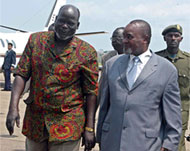Garang: Rebel leader to vice-president
Sudan’s First Vice-President John Garang’s death will come as a severe blow to the newly cemented peace deal that ended a 21-year-old civil war between the mainly Christian south and the Muslim dominated north and government.

Born in the remote Bor district in 1945, near the Nile River, Garang was among the few in then British-controlled southern Sudan to enjoy education beyond primary level.
After completing his secondary education in Tanzania, he went on to study economics at Grinnell College in Iowa, the United States.
In 1970, he walked away from a graduate fellowship offer at the University of California, Berkeley, to take up arms against the Khartoum government, following the deterioration in relations between the south of the country and government.
Military training
The so-called Anyanya uprising ended with a 1972 Addis Ababa peace agreement under which Garang joined the Sudanese military, eventually rising to the rank of colonel and once again returning to the US, but this time to receive officer training at the US army infantry school in Fort Benning, Georgia.
 |
|
Garang (L) and President Omar |
He returned to southern Sudan in September 1983 and led a southern army unit in his home town that defied orders to relocate to the north – orders they saw as violating a deal that ended Sudan’s first civil war in 1972 with a promise of southern autonomy.
The 105 Battalion of the Sudanese Army became the nucleus of the rebel Sudan People’s Liberation Army (SPLA), the armed wing of SPLM, which took up arms fighting for self-determination in the southern part of the country.
Also in the same year, Khartoum tried to impose Islamic sharia law and the result was civil war breaking out; inflaming religious and ethnic divisions. The war cost the lives of some 2 million people, many through famine and disease.
SPLA
The SPLA’s ideology varied from Marxism to later on, drawing support first from Ethiopia, then from Christian fundamentalists in the US. There was always a lot of confusion on central issues such as whether the SPLA was fighting for independence for southern Sudan or merely more autonomy.
 |
|
Garang (L) was in Uganda to |
Garang was known for not tolerating dissent and those who disagreed with him or the leadership were believed to have been either imprisoned or killed.
And in the dangerous world of guerrilla warfare, many attempts were made on his life from those within and outside his movement.
However, many critics charged that Garang and his senior leaders of the SPLM had spent much of the conflict away from the war-torn region in the comfort of Nairobi, Kampala, Cairo, Toronto and Washington.
The long conflict was itself fuelled by oil, with southerners laying claim to the oilfields that provide the government with vital revenues.
Peace at last
But after a long and painstaking conflict, eventual negotiations between Khartoum and SPLM gave way to a framework agreement in July of 2002.
Sustained efforts culminated in the signing of the comprehensive peace accord in January 2005 in Kenya where the north and south armed conflict was officially brought to an end.
The peace deal gave roughly half the oil wealth to the south. Garang’s SPLA says it controls most of the south, a vast but undeveloped region of swamp, savannah and bush with few roads, electricity, schools or hospitals outside a few garrison towns.
After being sworn in as first vice-president, Garang faced the huge challenge of rebuilding the south and war-affected areas in the Nuba Mountains and the southern Blue Nile, one of Africa’s least developed regions.
The 60-year-old leaves behind a wife and six children.